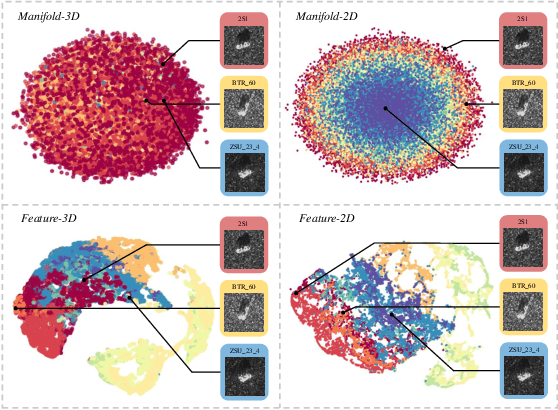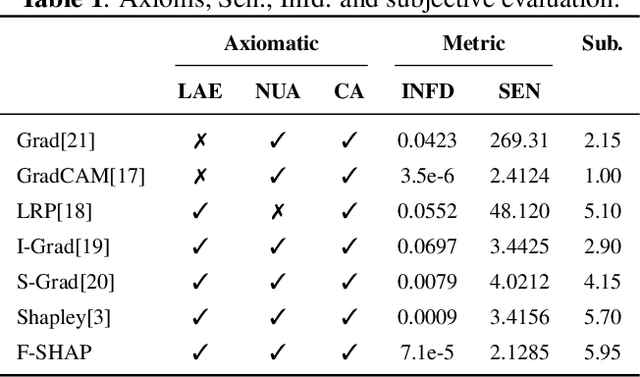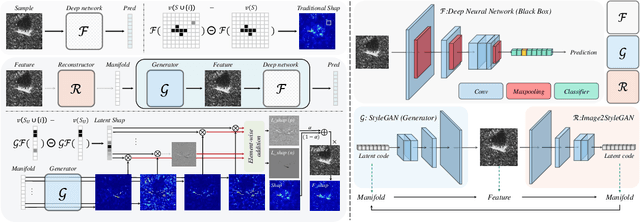Xuran Hu
Perturbation on Feature Coalition: Towards Interpretable Deep Neural Networks
Aug 23, 2024Abstract:The inherent "black box" nature of deep neural networks (DNNs) compromises their transparency and reliability. Recently, explainable AI (XAI) has garnered increasing attention from researchers. Several perturbation-based interpretations have emerged. However, these methods often fail to adequately consider feature dependencies. To solve this problem, we introduce a perturbation-based interpretation guided by feature coalitions, which leverages deep information of network to extract correlated features. Then, we proposed a carefully-designed consistency loss to guide network interpretation. Both quantitative and qualitative experiments are conducted to validate the effectiveness of our proposed method. Code is available at github.com/Teriri1999/Perturebation-on-Feature-Coalition.
Multi-task SAR Image Processing via GAN-based Unsupervised Manipulation
Aug 02, 2024



Abstract:Generative Adversarial Networks (GANs) have shown tremendous potential in synthesizing a large number of realistic SAR images by learning patterns in the data distribution. Some GANs can achieve image editing by introducing latent codes, demonstrating significant promise in SAR image processing. Compared to traditional SAR image processing methods, editing based on GAN latent space control is entirely unsupervised, allowing image processing to be conducted without any labeled data. Additionally, the information extracted from the data is more interpretable. This paper proposes a novel SAR image processing framework called GAN-based Unsupervised Editing (GUE), aiming to address the following two issues: (1) disentangling semantic directions in the GAN latent space and finding meaningful directions; (2) establishing a comprehensive SAR image processing framework while achieving multiple image processing functions. In the implementation of GUE, we decompose the entangled semantic directions in the GAN latent space by training a carefully designed network. Moreover, we can accomplish multiple SAR image processing tasks (including despeckling, localization, auxiliary identification, and rotation editing) in a single training process without any form of supervision. Extensive experiments validate the effectiveness of the proposed method.
SAR Despeckling via Regional Denoising Diffusion Probabilistic Model
Jan 06, 2024Abstract:Speckle noise poses a significant challenge in maintaining the quality of synthetic aperture radar (SAR) images, so SAR despeckling techniques have drawn increasing attention. Despite the tremendous advancements of deep learning in fixed-scale SAR image despeckling, these methods still struggle to deal with large-scale SAR images. To address this problem, this paper introduces a novel despeckling approach termed Region Denoising Diffusion Probabilistic Model (R-DDPM) based on generative models. R-DDPM enables versatile despeckling of SAR images across various scales, accomplished within a single training session. Moreover, The artifacts in the fused SAR images can be avoided effectively with the utilization of region-guided inverse sampling. Experiments of our proposed R-DDPM on Sentinel-1 data demonstrates superior performance to existing methods.
Manifold-based Shapley for SAR Recognization Network Explanation
Jan 06, 2024



Abstract:Explainable artificial intelligence (XAI) holds immense significance in enhancing the deep neural network's transparency and credibility, particularly in some risky and high-cost scenarios, like synthetic aperture radar (SAR). Shapley is a game-based explanation technique with robust mathematical foundations. However, Shapley assumes that model's features are independent, rendering Shapley explanation invalid for high dimensional models. This study introduces a manifold-based Shapley method by projecting high-dimensional features into low-dimensional manifold features and subsequently obtaining Fusion-Shap, which aims at (1) addressing the issue of erroneous explanations encountered by traditional Shap; (2) resolving the challenge of interpretability that traditional Shap faces in complex scenarios.
 Add to Chrome
Add to Chrome Add to Firefox
Add to Firefox Add to Edge
Add to Edge